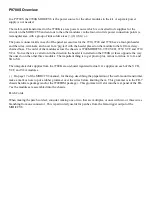
Great Bay Community College
Document
Number:
1.16.1
320
Corporate
Drive
Revision
Number:
5
Portsmouth,
NH
03801 Effective
Date:
20May09
Page 14 of 20
Title: New Brunswick BioFlo 3000 Bioreactor SOP
8.21.1.
Select “End Batch.”
8.21.2.
Exit BCLite program.
8.21.3.
On the desktop, select DBViewer32.
8.21.4.
Select browse and choose the file used during the run.
8.21.5.
Export the data to Microsoft Excel.
8.21.6.
Turn all the control modes (Temp, pH, Agit, DO, Feed 1-5) on the Bioflo 3000
controller to off.
8.21.7.
Turn off the BioFlo 3000.
8.21.8.
Turn off the water flow.
8.22.
Clean the BioFlo 3000.
8.22.1.
Make up approximately 4 liters of 10% bleach solution. Label each vessel
containing the bleach solution as: 10% Bleach, [date], [initials], Store: Room
Temperature, Dispose: Drain.
8.22.2.
Disconnect all cords and tubes on the outside of the vessel assembly.
8.22.3.
Pour 3L of 10% bleach solution into the vessel through the inoculation port.
8.22.4.
Soak the vessel in the 10% bleach solution for approximately 15 minutes.
8.22.5.
Remove the agitator motor and wipe down with a sponge using 10% bleach
solution.
8.22.6.
Remove the headplate from the vessel.
8.22.7.
Remove the baffle from the vessel. Clean the baffle with water and glassware
detergent. Scrub clean with a soft brush if needed. Rinse thoroughly with tap
water and then with deionized water.
8.22.8.
Remove the vessel from the heat exchanger base and pour the bleach solution
down the drain. Rinse the vessel thoroughly.
8.22.9.
Remove the plastic plugs from the vessel.
8.22.10.
Clean the vessel carefully with warm water, glassware detergent and a sponge.
Rinse thoroughly with tap water and then deionized water.
Note: Handle the vessel gently, the glass is very brittle.
8.22.11.
Clean the plastic plugs and thumb screws (large and small) thoroughly with
warm water and glassware detergent. Scrub clean with a soft brush if needed.
Rinse thoroughly with tap water and then with deionized water.
8.22.12.
Remove all probes and tubes from the topside and underside of the headplate.
8.22.13.
Place DO and pH probes securely in the probe stand and place the shorting caps
on the top of each probe.
8.22.14.
Clean all bioreactor tubes with a soft cloth, warm water, and glassware detergent.
Rinse thoroughly with warm tap water, and then with several changes of
deionized water.
Note: A soft brush may be used on difficult to clean parts of the bioreactor
vessel.
8.22.15.
Clean the inside of the sparger tube to remove clogs and prevent damage to the
bioreactor on a future run.
8.22.16.
Remove the pH and DO probes one at a time from the probe stand and gently
clean the probes using a soft cloth and deionized water. Be careful not to harm
24






































